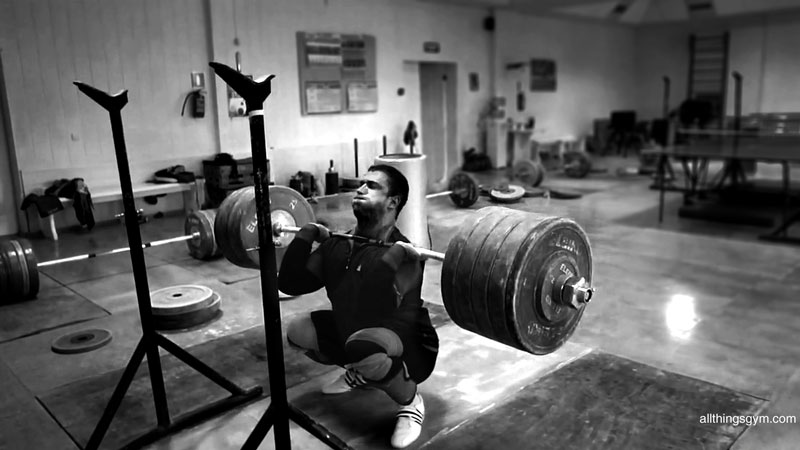Squatting. Isn't that what weightlifting is all about? I mean intuitively, weightlifters have a tendency to find themselves in a squatted position with a bar either overhead or across their shoulders. So naturally, one would assume that an integral part of weightlifting is the stability and strength required to be in that position. If one was to make such an assumption, he would be correct! If this intelligent person then extrapolated to thinking about how to benefit the classical lifts (Snatch and Clean & Jerk), and came up with the idea of isolating this portion of the classicals to strengthen in training, he would be my hero!
Enter the Back and Front Squat!
 |
| This beautiful, hairy Russian man is responsible for one of the most iconic pictures in weightlifting, as well as the second highest recorded Clean and Jerk of all time! Also, moustache. |
Front Squats on the other hand are a little bit more elusive. Loading the bar across the front deltoids results in a very different, but similar movement to the back squat. It also means you can lift less, are forced to keep strict form, and if you suck like me, have a tough time breathing :p
 |
| Everyone's favourite weightlifter - Dimitry Klokov performing a (really heavy) Paused Front Squat. Kind of looks similar to the position at the bottom of a Clean doesn't it?! |
There are many different ways that people squat. In the end, any given person's squat position is dictated by his proportions, weaknesses/strengths, flexibility and intent.
As weightlifters, our aim when squatting is to directly aid the classical movements. As such, our intention is never to lift maximal weights, but to lift in a way with maximum transferability to the classicals. In other words, we want to strengthen our bodies in the same position that they would find themselves in when performing a classical.
 |
| I got this picture from google like any good boy, but I believe it is from a book called "Starting Strength" |
With that being said, the above picture is a good illustration of various squatting positions. One important thing to note, is that the bar is always in line with the mid-foot. This is an essential to any good squat, as any heavy weight must be lifted through the natural area of balance (i.e. the feet for humans). Think about it, have you ever tried squatting a weight such that the bar is far out in front of your toes? Well, it is impossible. To accommodate this "centralness", and the center of gravity of the bar-human system, the torso will lean to a different degree and the hips will change their distance from the ankles.
On a tangent, because the bar will at some point be a heavy heavy weight, pushing the center of gravity (of the system) up the torso, the natural tendency is for it to pull the athlete forward. In accordance with the first law stated above about mid-feet, this usually means that the hips must shoot back hard to balance, which is undesirable (albeit often unavoidable) for any application.
If you look at the first drawing, it is of an athlete performing a Front Squat. You can relate this with the above picture of Klokov. As is evident, a good Front Squat requires a very upright torso. For weightlifting intents, this is a very desirable position. Like any other squat, the exact uprightedness of the torso will depend on limb proportions and flexibility. In the end, the body will naturally obey the law of centralizing the weight, and lean the torso over according to how far back the hips are. However, since the bar is in front of the body (and also because it may just drop out of your hands if you lean over too much), any athlete will be more upright in a Front Squat than Back (Remember, the weight must stay over mid-foot and the back will be at an angle to accommodate this. With the bar in front, less torso lean is required to maintain the position).
Our intention as weightlifters is to minimize torso lean, and squat in a way that the hips are as close to the ankles as possible - thus achieving the desired upright torso. This is the exact position you would want to receive a clean it. It provides great stability, and allows the load to be taken by strong trunk musculature and legs as opposed to the lower back and hips. On the other hand, this means that most athletes (especially with weak abs, quads and glutes) have a tough time squatting from this position.
Furthermore, weightlifters generally squat as deep as possible. This is because we move our bodies as low as possible to receive the heaviest Cleans and Snatches. As such, we need to develop strength coming out from the bottom of the hole. Keeping the hips close the ankles (i.e. upright torso) allows us to maximize this depth in a stable and safe manner.
On the other hand, many athletes (especially in sports like Power lifting) prefer a type of squat that results in lots of forward lean, with the hips far back and the shins vertical. This makes sense for their application. More torso lean usually results in better activation of the powerful posterior chain, combined with cutting depth, massive weights can be moved using this method of squatting.
Well, I probably made a bit of a mess of explaining squats up there, but I digress. Squatting is obviously important to weightlifting. Or rather, it is more than important - it is probably almost definitely essential. Not only does an athlete gain vast amounts of general strength, but if performed correctly, gains strength with excellent carry over to what he is training (the classicals).
But herein lies the issue. You see friends, squatting is tiring...very tiring. It is exceptionally fatiguing, and requires immense energy. Any given weightlifter only has so much energy and time to spend, and must utilize all he has to the best of his ability to improve the lifts with which he competes. A good weightlifter (i.e. not me!) keeps this in mind. It is easy to get caught up in improving squat numbers and looking strong with big plates on the bar, but one must remember that the end goal is an improvement to the classicals. Of course, it can be argued that squatting strength is always beneficial. This is definitely true, but a four plate (405lbs) will not help you snatch a weight that corresponds to that squat if you do not train the Snatch.
On the other hand, after consistency and decent technique have been achieved, the classicals seem to correlate really well with squatting. This is exceptionally true for Front Squats and Cleans, as would be intuitive. Greater Squat strength will make it easier to stand up, stabilize, and control a heavier weight. It will also save more energy for the jerk, and alleviate much mental stress.
Additionally, a different attitude must be taken to squatting for weightlifters. As stated, squats must be used in a way that best corresponds to improving the classicals. The intensity with which a weightlifter programs his squats must always keep this in mind. Remember, we are not trying to improve our squat in specific. We need to always be squatting with the classicals in mind. This means, we do not spend excessive energy on squats, and we use weights that allow us to squat with good positions and speed that would help when it came time to stand up after a clean. Generally speaking, super heavy weights that result in eyeballs popping out of their sockets are not what a weightlifter needs (of course, situational exceptions do exist).
So it seems that an important balance must be struck between the pains of squatting and joys of all other types of weightlifting.
In the end, it all depends on the given athlete and his weaknesses. Training must always be structured around strengthening weaknesses. If an athlete misses lifts because of lack of leg strength, it makes absolute sense to throw in lots of squatting and maybe even take on a strength cycle where the classicals are shrugged off for a while. On the other hand, a weightlifter squatting 405lbs but continuously missing 135lb Snatches would benefit far more greatly from a training methodology that does not spend too much energy on squats.
If I was to use myself as an example, I must say that I have always sucked at squats. In fact, squats have always been the part of my training session that drained away my soul and left me an unhappy (but handsome) man. This has changed somewhat recently, as I have gotten better at the movement. But, for most of my training career, it has always made sense for me to squat often and with great vigour. Funnily, at the moment I am in a position where my classical lifts can be improved without increasing the squat strength. However, I blame scheduling conflicts and the convenience of a strength cycle during school term! :P
The important thing, is that squatting strength will always be beneficial. But the question we have to ask ourselves, is if at the moment, is that what we need to spend our energy on? As in, will squatting improve our classicals more than doing pulls, complexes or variations of the lift?
In the end, I must admit my hypocrisy. For me, the last four months have been spent on a strength cycle. At this point, I am okay with where the squatting strength is, and hope to shift more focus towards the classicals over the co op term. This does not mean I won't be squatting. It simply means that I won't be squatting as often with as much intensity. I know that my classical progress previously has been seriously impacted by just being too tired because I was going so hard on squats.
All that being said, this post has been written today because I finally hit a long awaited Back Squat PR - the coveted 3 plate lift (143kg / 315lbs). Check it out below:

No comments:
Post a Comment